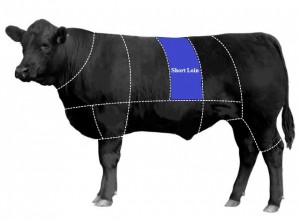
Beef Short Loin
This is a funny misleading name for this remarkable part of the Wagyu. The Short Loin is positioned after the Rib and before the Sirloin. This primal yields the super tender, highly sought-after, Strip Steak, Tenderloin and Hanging Tender.
Sirloin Strip is a misleading name. It is part of the Short Loin, not the Sirloin. It follows the Rib Eye laying on top of the Rib Bones. The Wagyu Sirloin Strip produces two 12-16 lb. cuts. With the bone on, it is called the Kansas City Sirloin and with the bone removed it is the New York Sirloin Strip Steak. With the bone on, including the Tenderloin, it becomes the Porterhouse.
New York Sirloin Strip (Boneless) is commonly known as the “New York Strip” steak and is best grilled.
Kansas City Sirloin (Rib Bone on) contains the rib bone which allows the bone to protect the meat on one side allowing high temperature grilling to retain the most amount of juice in the meat.
T-Bones (Spine and Rib bone on) is the latter section of the Short Loin after the Tenderloin in the Porterhouse has ended. It is a Sirloin Strip with the rib and spine bone attached.
Porterhouse (Sirloin Strip & Tenderloin together) is a combination of the Sirloin Strip, Tenderloin with the rib and spine bones structure that connects them. It is an extremely large steak which must be cut quite thick to develop the rich Wagyu flavor during grilling. The Porterhouse is the best steak to share with 2 or more. The inherent challenge to grilling the Porterhouse is that the Tenderloin cooks faster than the Sirloin, which may be adjusted by varying heat levels on the grill and foil wrapping the tenderloin section to slow the cooking.
Tenderloin is a great name for this muscle which is located in the Loin area beneath the ribs and under the spine. It is commonly known as the “Filet.”, from the French name “Filet Mignon” traditionally cut from the smaller diameter section. It is super tender because it is not a hard working muscle. The largest part or head of the Tenderloin starts opposite the sirloin section and runs forward along the Short Loin getting smaller as it approaches the forward end almost to the Rib section. The Tenderloin is great to cut into steaks and grilled. The head produces the wider typically thinner steaks while the center section is known as producing “barrel cuts” because of their perfect round shape. As the Tenderloin narrows this is the true “Filet Mignon steak.” As it tapers off into the tail it becomes even smaller, great for medallions to be sautéed or turned into steak tidbits. Wagyu produce two tenderloins approximately 6 lbs each.
Hanging Tender is derived from the below the diaphragm which is the forward and thickest part of the Flank Steak. It is attached to the Short Loin area and underneath the rib cage. Each Wagyu produces one Hanging Tenders about 1 ½ lbs. each, often seamed into 2 cuts due to inedible membrane running down the center. It can be cut into portions, grilled with great flavor and tenderness although it is not as tender as Tenderloin.
Flank Steak are abdominal muscles positioned internally under the Short Loin. This muscle is great for grilling and slicing. The Wagyu has two at about 1 ½ lbs each.
Flank Flap lies below the Flank Steak and is similar in size. It is great for grilling, slicing and quite tender. It may also be braised for stews and ragouts. The Wagyu has two of these cuts at about 2 ¼ lbs. each.
Baby Back Rib bones from the Short Loin area are leaner than the Rib area (although they have the same name.) They are best roasted, braised or barbecued to develop the flavor and tenderness. Adjust your portion size to reflect the lower meat to bone yield in this cut. Wagyu yields 2 of about 1-1/2 pounds each.



